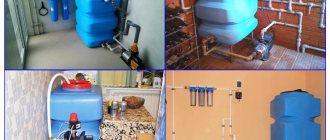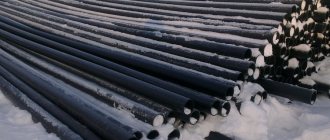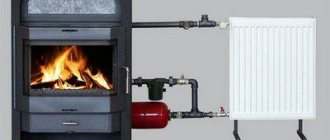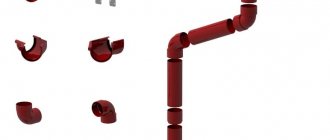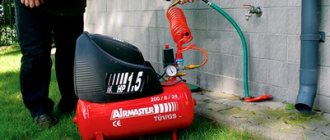__________________________
How to preserve a well for the winter - this issue must be resolved before the onset of cold weather and during the dry season. Well conservation is used if you decide not to use it in winter.
This means that you will no longer be able to use water either in the house or outside. The well will be tightly closed and access to it will be terminated. The water supply leading from it to the house will be shut off. If you decide on this option, let’s take a closer look at what methods exist for preserving a well.
Preparing the cottage for winter: draining the water
All properly designed water supply systems in country houses for seasonal residence, regardless of the material of the pipes, shut-off valves, operating pressure and location of the pump, are basically the same:
- The pipes have a slight slope towards the well or well.
- The pipe through which water enters the house has a check valve (in the well or in the house, next to the accumulator). In operating mode, it prevents water from draining.
To drain all the water from the water supply, the owner of the dacha must stop the operation of this valve, then the water will return back to the well, or, if a well is used, it will drain into a special drain. Therefore, a drain valve is installed on the pipe between the check valve and the hydraulic accumulator (a valve with a long handle is placed in the well so that it can be opened and closed from the surface of the ground).
When the check valve is installed on a pipe in the house, next to the accumulator, the drain valve is installed on a parallel pipe.
Sometimes the system is not installed quite correctly, and there is no parallel pipe with a drain valve. There is no other way out - all that remains is to disassemble the water supply unit and drain it manually.
When draining water from the system using a drain tap, you need to ensure that all mixer taps are in the open position at this time.
After draining the water, you need to disassemble all the filters that are installed in the system in front of and behind the hydraulic accumulator, remove the cartridges and send them for storage.
Features of using a well in winter
If we assume that the water surface is 8 meters and the freezing depth of the ground cover is 2 meters, then there is nothing to freeze in a well closed for the winter. The weak point from the point of view of freezing in any water supply system, using any type of well, is the pipeline , through which water enters the home. If there is water left in it, it will begin to freeze already at zero temperature, which leads to damage to the pipe, and sometimes to failure of the entire system.
The installation of the pipeline system must be carried out below the soil freezing zone - 1.5-2 meters. Often, in order to save money, they equip the well with their own hands and do not take these installation requirements into account. The results can be very disastrous.
If the water supply in your area is made at a shallower depth, then it is additionally recommended to lay a heating cable. Its installation does not require much knowledge and skills. The simplest technique is to lay polystyrene foam boards with a thickness of at least 10 cm on top and cover them with film or fiberglass. Add additional snow on top.
Therefore, removing water from the system is the main stage in preserving the well and water supply for the winter. Already when designing a water supply system in a suburban area, you need to decide whether you will live here permanently or only during the summer season. If there are questionable places in the pipeline, then be sure to provide for draining the water. At the same time, you need to understand that not all the liquid will leave after simply opening the taps.
Therefore, it is better to plan and install drain pipes in bends and other problem areas, which will allow water to be completely removed from the entire water supply system. It is recommended to install a tee in the line, through which the remaining moisture could be removed from the system with air.
How to drain water from a pump for the winter
The next important part of the system is the pumping station. If it is installed in the house, be sure to empty the water from it. If it’s in a well or borehole, then, theoretically, you don’t have to do anything at all - the freezing depth in the Moscow region is 1.5 meters, and pumps are installed deeper.
Sanych1415 Member FORUMHOUSE
The main thing is that the hose can withstand temperature changes. If it holds up, then there is no problem.
But in practice, when using a well or well seasonally, FORUMHOUSE participants, at the end of the summer season, pull out the pumps and take them to the city so that the equipment can winter in a warm room.
Andrey 203 FORUMHOUSE Administrator
At the end of the season I sort everything out. The pump and automation are stored at home at positive temperatures.
To drain water from the pumping station, you need to turn off the power and unscrew the drain plug, which is located in the lower part of the pump housing. The pump should be tilted towards draining the water, and to ensure complete drainage, turn it upside down.
Winter water supply device
If you are going to live outside the city all year round, the water supply in a private house in winter should be arranged so that it does not fail even in the most severe frosts. To achieve this, you will have to complete a number of mandatory activities.
They are quite labor-intensive and expensive, but the cost of restoring the system after freezing will be much more expensive. Especially if equipment and pipes laid hidden behind the wall cladding freeze.
Measures for thermal insulation of the water supply system
As a rule, water is supplied to a country house from a well or borehole if it is not possible to connect to a centralized water supply. And if the water in the sources almost never freezes, since it is located at a considerable depth, then the supply system quite often suffers from frost.
To prevent this from happening, you should take care of its thermal insulation. To do this you need:
- Insulate the lid and walls of the well, and build a caisson over the well head. This is a metal, brick or plastic bunker buried in the ground, which is insulated from the inside and waterproofed from the outside.
- Pumping equipment that can function normally only at positive temperatures is installed in a warm room. This could be the basement of a house, a boiler room, or the same caisson above a well.
Note. Warm installations require surface pumps. Submersibles do not freeze while in water.
- From the source to the house, pipes are laid in a trench, the bottom of which should be below the freezing level. To be on the safe side, they can be additionally insulated with special materials.
Winter water supply for a dacha from a well involves the installation of a caisson
Caisson arrangement diagram
The pump can be installed in an insulated caisson
Scheme of laying a pipeline into a house
Insulated well head
The storage container in the attic also needs to be protected from the cold.
Laying pipes in a trench with additional thermal insulation
Insulation of pipes is necessary in areas above the freezing level and passing through the base into the house
- It is also important to ensure that the external walls are not blown through, especially at the base adjacent to the foundation. The gaps there need to be sealed. Since water pipes are usually laid along the floor along the walls, the water in them can freeze.
- Ventilation vents in the foundation must be closed during the winter.
Pipe insulation
If water supply to the dacha is necessary in winter, but the pipe system is laid in such a way that they can freeze, they must be insulated. There are several ways to do this, and the simplest is to enclose them in a thermally insulating foam shell, wrap them in mineral wool or other similar materials.
Foil polyurethane foam shell
But this method can only be considered as an auxiliary measure, or used for thermal insulation of pipes laid under the floor or in the basement, passing through the cellar or other rooms with low air temperatures.
I'll explain why:
- No amount of thermal insulation can keep you warm. It only retains heat. In severe frosts, it will not protect pipes from freezing, especially if they are open or laid above the freezing level of the soil.
- Moreover, the frozen water in them will take much longer to thaw, because the insulation will also prevent the flow of heat inside.
- Corners, tees and shut-off valves are much more difficult to insulate than a straight pipeline. And they are precisely the weakest point of the system.
Shut-off valves are the weak link of the water supply system
For reference. Different thermal insulation materials for pipes have different ability to retain heat. It is lowest for sleeves made of foamed polyethylene.
Therefore, in problem areas, pipes need to be not just insulated, but heated. To do this, use an electric heating cable or tape that is attached to the pipe. Or a heating wire inside it.
Water supply pipe heated by internal electric cable
But thermal insulation materials, when used together with a heating cable, will help you significantly reduce energy costs by reducing heat loss. They will also retain heat for some time during a power outage, which often happens in winter in countryside villages.
Heating tape and insulation guarantee the operation of the water supply system in any frost
Advice. If you do not live in the house permanently, consider a warning system in case of a power outage so that you can respond in time and prevent the pipes from freezing. In this case, it is advisable to have an alternative source of energy supply.
How to drain water from a water heater
Having dealt with the pump, we move on to water heaters: storage heaters are usually installed in summer cottages, and on the eve of winter, the water from them must be completely drained. The heater is not intended for operation at subzero temperatures, and if even a little water remains in the device, it will not survive the winter.
Unfortunately, dacha owners often make mistakes when draining water in heaters and leave some water inside the device.
This is what happened to a user of our portal with the nickname megakino: he has a storage heater under the sink in his dacha. The instrument panel did not survive the first winter - it was squeezed out, and after the second, frozen water tore the entire hull.
Our user does not understand what happened: it seems that he drained the water according to all the rules and left the taps open for the winter.
Here's how FORUMHOUSE participants explained this mystery: the water from the heater was not completely drained; it was prevented by the check valve installed on the water supply. To accurately drain ALL the water from the water heater, you need to blow it out. The main thing here is not to confuse the cold and hot water inputs:
- open the cold water drain and supply hot air into the hot water pipe. The cold water inlet is located low, and when blowing into it, all the water can be displaced without any residue.
Jackson FORUMHOUSE User
If you do the opposite, you will get nothing but bubbles in the heater volume.
You can do it easier and install a water heater drain tap.
This is how the heater drain is equipped for our participant with the nickname Liftanuty.
A simple way to preserve barrels in the cold
There are barrels at the dacha collecting drainage. In the spring, the water supply is not yet working, but water is needed for irrigation and other things, and barrels help out.
But the problem is how to prevent them from tearing in winter?
I tried putting five-liter bottles with gravel at the bottom, it works, but you need a lot of bottles and it’s inconvenient to put gravel in them, and then cut it and pour it out.
And so this method was born:
Possible duplicates found
Turn over on October 17, turn over again on April 17, in accordance with the order of the USSR Minister of Defense on the transition to winter/summer uniforms. If you are not in Turkmenistan and not in the Polar Region.
And we just turn the barrels over for the winter. Do it once.
If you are planting on an industrial scale, it makes sense to make a well or a well on the site, but there is enough water for everything else. For us, at least.
Yes, we do too. I thought you were just too lazy to leak ;)
In early spring, throw snow into barrels.
The barrels are left filled for the winter, for example at dachas, where planting begins even before the irrigation system starts. So as not to carry water with you in cans, you can stock up in the fall.
Thanks for the interesting recipe. The mother-in-law simply inserts half-decayed long sticks with one end into the water to the bottom, and this also helps maintain the integrity of the barrel, but with bottles it is somehow more reliable.
Well, if you don’t have a ditch, then you can leave it. In general, dachas have water pumps, ponds, etc. There is already so much water in the spring that it would be better to store it in the fall.
My dacha is located far from the reservoir, from where water is actually drawn during the irrigation season, which begins in May.
There is an option to arrive before the snow has completely melted (somewhere at the end of March) and throw the remaining snow, swollen with moisture, into a container, as well as into a greenhouse. But it’s still more convenient to store water in the fall and, when you arrive in April, already have water for watering and planting plants in the greenhouse.
Yes, I don’t mind) initially I thought that I was just too lazy to drain it. I didn’t know that water could be so tight
We always just left a couple of boards in the barrel and that’s it, it doesn’t tear.
if you can’t see the difference, why reduce the useful volume of the barrels?))) I also just put a board and that’s it, nothing tears, doesn’t swell)))
and how often do you have such an apocalypse?)
I don't understand how this shit works
They always left a couple of boards vertically in the barrels and that was it.
Soooo, five liter bottles with gravel - I can do it, I can do it.
When water expands when it freezes, it compresses the bottles, and the excess volume from the expansion goes into them.
You just need to throw a piece of wood and let it float. It won't tear - checked.
What are you planting that a couple of barrels of melt water is enough for you? I took an eight-ton tank - enough for a month at most if there is no rain. So my whole plot will be like a warehouse for barrels for watering this plot.
Will the ice have time to melt by the time water is needed for irrigation?
How to drain water from a washing machine and dishwasher
If a washing machine and dishwasher are left to spend the winter at the dacha, then they will also need to be dehydrated. There can be difficulties with dishwashers, as our users say, “they have real labyrinths for water inside.” Therefore, if the manufacturer’s instructions do not directly indicate that the device can be wintered in an unheated room, and the preparation steps for such wintering are not outlined, it is better not to take risks.
With washing machines everything is simpler. To drain the water from the washing machine, you need to:
- Disconnect the machine from the water supply and sewerage. Place the ends of both hoses into a low basin. Turn on the "drain" mode. Wait for the work to finish.
- Disconnect the machine from electricity. Place a flat container like a cat litter box and unscrew the drain pump cover.
- To be completely sure, you can turn the washing machine upside down and leave it to winter in this position.
But some models of washing machines have containers inside in which water may remain, and if not, access to them is possible only through partial disassembly.
We're staying for the winter
If we stay in the house, then all we need to check is the water supply to the house. We will keep the house warm anyway.
If your winter water supply was originally made from a well or borehole and the pipe is buried deep in the ground (on average 1.5 meters), there is nothing to worry about.
An exception may be a house that stands on posts or, in construction language, on a pile-screw foundation.
In this case, you need to check whether the heating cable is installed on the inlet pipe or inside it.
Eat? Just plug it into a power outlet. If it is not there, then you will have to invite a specialist to install it, since the operation is not simple.
- Characteristics of HDPE pipes for water supply
- Cold welding for plastic water supply pipes
- Installation of water supply in a private house from a well
Extreme wintering
In my practice, there have been cases when people did not have enough money to bury a pipe in the winter, and their life situation forced them to spend the winter in an unfinished country house. The water supply pipe came from the well at a depth of one spade bayonet.
Usually, as long as this layer of earth froze, snow had time to fall.
Tip: if you know where your pipe goes, shovel the snow above the pipe in several layers. 40 centimeters of snow or more will no longer allow the severe frost to pass through.
At the same time, water was used frequently in the house. And at night, in severe frosts, they opened a thin stream so that there was a flow of water, so that it did not have time to freeze.
Of course, this method is extreme, but it can also be a way out of the situation.
Make sure that the place where your pipe is inserted in the house is warm. That is, if your water supply starts from the veranda, where there is access to cold, insulate this room and do not allow the temperature to drop below 10 degrees.
Perhaps this is all you need to do if you are spending the winter in a country house.
How to bleed the water supply system at your dacha
To be completely sure that there is no water left anywhere, the dacha water supply system will have to be purged. Even a small amount of water in winter, turning into ice, can burst a pipe.
Jackson FORUMHOUSE Member
For the winter, I always blow all the pipes with air step by step, along different lines, because when simply draining, “bags” of water still remain.
Blowing is done with a valve to which a car compressor is connected. It is screwed to the ends of pipes or flexible hoses unscrewed from the water heater.
During blowing, the faucet taps should be closed and the drain taps should be open. After blowing, it is necessary to open all the taps, both drain and mixer taps, and leave them in this position until spring.
Here's why this is done: almost always, the shut-off valves in country water supply systems are ball valves, and in their design there is a cavity where water can remain. For the same reason, you need to unscrew the shower head, shake the water out of it and put it into storage.
To summarize, preparing a country water supply system for winter includes the following mandatory steps:
- draining water from the system through the drain valve;
- draining water from the pump;
- draining water from the water heater;
- draining water from the washing machine and dishwasher.
- gradual purging of all pipes.
Now all that remains is to remove water from the most dangerous elements of the drainage system: disassemble the siphons under the sinks, drain the water from the toilet tank and drain the water seal (for example, with a rubber bulb). In winter, instead of water, the water seal is filled with antifreeze - this way, unpleasant odors from the septic tank will not enter the house.
All that remains is to prepare the water supply and septic tank for wintering.
Conservation of street water supply
In the vast majority of cases, street domestic water supply is laid from long sections of polyethylene HDPE pipes, the technical characteristics of which are regulated by GOST 18599-2001. According to the document, the operating temperature of HDPE pipes for drinking water purposes is in the range from 0 to +40 °C (standard value + 20 °C), and they must withstand a nominal pressure of at least 25 Bar.
Considering that usually a polyethylene water supply is laid underground at a depth below freezing, in the absence of water inside it is not in danger of destruction of the shell under any weather conditions, therefore, it does not need conservation.
It is theoretically possible for HDPE pipes to be on the surface in winter in open coffered pits and wells in the conditions of the Far North at very low temperatures; in this case, any tubular insulation made of foamed polyethylene or rubber - Jermaflex, Porilex, Energoflex, Vilaterm - is perfect for protecting them from the environment .
But it should be borne in mind that any heat insulator only slows down the freezing process, and does not stop it. Therefore, in the event of a long absence of owners, it is possible to reliably protect any external pipeline from frost only with the help of an electric heating (self-regulating) cable operating in automatic mode. It is tied to a pipe or placed inside using modifications made from food polymers.
Rice. 10 Examples of organizing winter drainage into the sewer system inside the house
If the design of the external and internal water supply for individual water supply meets all the basic technical requirements - the required slopes, taps for draining into the sewer system inside the house, special valves in the well pipeline, then preparing the system for winter will not take much time and will be effective. When carrying out work, the main thing is to accurately follow all points of the instructions, which consist of a large number of small operations.
How to mothball a well
The well is preserved for the winter so that in the spring it is completely ready for use. This means that throughout the winter we will not be able to use it; access to water will be completely blocked. We have already done the main work: we drained the water from the pipeline, heater and plumbing fixtures, and removed the pump.
Now the well is not in danger, the main thing is to close the wellhead correctly: screw on the head, which will protect sheets, etc. from rain, snow, and seal it with film.
In a water supply system arranged according to all the rules, a caisson is made - it deepens the well below the freezing point, protecting it from rain and groundwater. A well with a caisson will survive any frost, the only thing is that this device is not cheap.
A FORUMHOUSE user with the nickname Lesha-Samurai has a fairly standard situation: there is a well 75 meters deep (self-flowing 10-15 m3 per hour), which will not be used in winter, and a categorical reluctance to install an expensive caisson.
According to FORUMHOUSE administrator Andrey 203, a caisson is the only reliable option in a leshy case.
Andrey 203
A caisson is needed to move the wellhead below the freezing depth of the soil.
However, a successful method of caisson-free well conservation has yet been found. Using this technology, Lesha-Samurai and his friend have been preparing their well for winter for several years now.
The algorithm is like this:
- Take 6-7 soda bottles (there should be some drink left in each bottle), shake each bottle to create pressure in them.
- Remove the head of the well and insert bottles into it.
- Put the head back.
- Pump air into the well using a car compressor through the nipple (pump for about 10 minutes). This will ensure that the water level in the well is reduced to the level of soil freezing.
- Shut off the air outlet from the well with a ball valve.
Lesha-Samurai
You can take a plug for 1, use a drill to make a hole of a suitable diameter in it and insert a nipple into it with oil.
Even if air leaves the well through elements of such a structure and the water level rises, the bottles will prevent its expansion.
Conservation, summer option
Summer arrangement speaks for itself; this option is intended for operation only at positive temperatures. Photo 1 shows the equipment used in summer construction.
To preserve the system for the winter, you need to perform several simple manipulations:
- Disconnect power from the pump.
- Open the water tap (number 1) installed after the automation unit.
- Wait until the pressure in the system is released. After the water pressure in the system drops to 0.5 bar, an automatic relief valve, mounted below the soil freezing depth, on the water rise pipe in the well will open. The relief valve can be seen in photo 2.
- Using a wrench, unscrew the detachable connection (number 2) in front of the automation unit.
- Remove the automation unit.
Conservation option with downhole adapter
A well equipped with an adapter can be used all year round; the pipes entering the house are at a depth of at least 1.6 meters. The hydraulic tank and automation, in the case of an adapter, are located in the house, as shown in photo 3.
Preservation in this option is performed as follows:
- Disconnect power from the pump.
- Open any water tap in the house. As in the case of the summer version, an automatic relief valve is installed on the water rise line. When the water pressure in the system drops to 0.5 bar, the valve will open and water from the pipeline entering the house will flow into the well.
In this case, dismantling with photographs is not required.
Conservation option with caisson
When constructing a well with a caisson, in most cases, the hydraulic tank and automation are placed in it. The conservation of this system consists of several points:
- Disconnect power from the pump.
- The shut-off valve on the pipeline entering the house must be in the open position, as shown in photo 4.
- Lower yourself into the caisson.
- Place taps number 1, number 2 and number 3 in the open position, as shown in photo 5.
- After all the water from the system has drained back into the well, open tap number 4 and drain the remaining water from the riser of the watering tap. In photo 6 you can see tap number 4.
From the brief instructions on mothballing wells, it is clear that mothballing a well for the winter is not difficult, but certain skills are required and our engineers perform this work in the process of servicing water supply systems.
__________________________
How to preserve a well for the winter - this issue must be resolved before the onset of cold weather and during the dry season. Well conservation is used if you decide not to use it in winter.
This means that you will no longer be able to use water either in the house or outside. The well will be tightly closed and access to it will be terminated. The water supply leading from it to the house will be shut off. If you decide on this option, let’s take a closer look at what methods exist for preserving a well.
How to insulate a well
Modern wells are made from reinforced concrete rings. This is a material with high thermal conductivity, and it will freeze. There is a particularly high risk of freezing in shallow wells, with a water level no higher than 1.1 - 1.2 meters, and in wells located in cold regions.
In regions with a temperate climate, it is enough to simply close the well tightly for the winter, or make a reliable house on top without cracks - the cold penetrates through the cracks, falls down and thus freezes the shaft.
Protasevich Consultant FORUMHOUSE
In a tightly closed well, the rings in frost are approximately 0.5-0.7 meters below ground level. The concrete rings themselves will not “conduct” the cold to the bottom.
But insulation of wells is also welcomed in the Moscow region. Frozen water in a well can damage pumping equipment, displacement of rings, and discrepancies in the joints between them.
Wells that are not insulated for the winter are more likely to need repairs.
If you have a blind area, you can insulate it too.
You can buy a ready-made “shell” for insulating wells, or you can insulate the structure with polystyrene foam or extruded polystyrene foam (these options are used by FORUMHOUSE members more often than others.
In what cases is the pump left in the well all year round?
When organizing water supply from a well, 2 types of pumps are used - surface and submersible. The latter variety descends into the well and is fixed at some distance from the bottom surface. This type of equipment is used all year round, so there is no need to remove it for wintering.
Surface-type pumps are mounted on top of the well, and water is transported using pipelines and hoses. In winter, such devices may suffer. Icy water remaining in hoses and pipes can cause damage to the storage tank or the entire mechanism.
To use a submersible pump all year round, it must be insulated. To install it you can use the following places:
- basement or ground floor;
- insulated building located near the well;
- inside the well (on a specially equipped shelf).
In each case, it is necessary to additionally insulate the lines passing into the home from the water source. If the pumping system has been properly insulated, it can be used year-round.
Recommended insulation for a well made of concrete rings
| Type of insulation | Features of the material | Installation technology |
| Styrofoam | Inexpensive, has good thermal conductivity, does not deform, and does not absorb water. Not resistant to rodents and insects. Sold in the form of ready-made elements corresponding to the sizes of reinforced concrete rings. | The walls of the well are cleaned of debris, façade glue is applied tightly, without gaps. Styrofoam is attached. If the foam does not adhere well, you can secure it with concrete dowel nails. Any barrier insulation material is laid on the foam. The trench is filled with earth and compacted. |
| Extruded polystyrene foam | Resistant to low temperatures, aggressive environments, and withstands loads well. Approximately 20% more expensive than polystyrene foam, produced in the form of slabs. | Installation is no different from installing foam plastic. The joints are sealed with polyurethane foam. The insulation is wrapped with rolled waterproofing material. |
We invite you to see how a member of our portal with the nickname pdp000 insulated his well
The insulation of the blind area is made of EPS, the walls of the ring are insulated with expanded clay. An insulated lid-liner is also made.
You can insulate a well with a little blood. Here are a few methods tested on FORUMHOUSE.
- Our user with the nickname Accurate covers the concrete ring of the ring with plastic film. Since then, the water supply pipe has not frozen even once - it was heated by well water, and the water did not freeze because the film did not allow the cold to pass through.
- Our participant with the nickname Hodok has been insulating a well from the inside for 40 years. Attach two frames made of thick wire in the form of inverted letters P to the last ring at a distance of 25 cm from each other. They descend to ground level. On them, Walker places two semicircles cut out of iron - this creates a flooring on which a plastic film is placed. He covers all the cracks with the same film, puts old clothes inside and leaves the well until spring. But this needs to be done when stable frosts arrive, so that the improvised insulation does not get wet from the fumes from the well.
Recommendations
If you do not take into account the possibility of theft, then if the well is sufficiently insulated, the pump can easily overwinter inside. To insulate it, it is recommended to make an additional overlap at a depth of about a meter from the ground surface.
A light frame made of bars is attached to the walls of the well shaft, on top of which foam sheets are laid. All joints between the edges of the sheets and the walls of the shaft are filled with polyurethane foam. After this, the threat of freezing of the pump located in the well will disappear completely.
